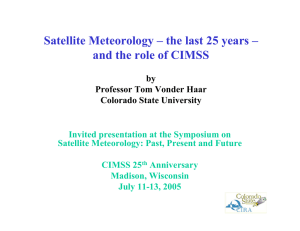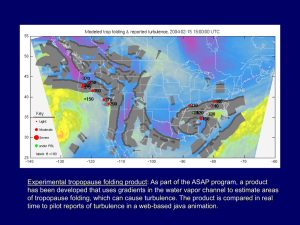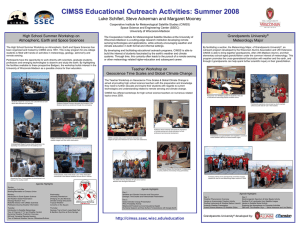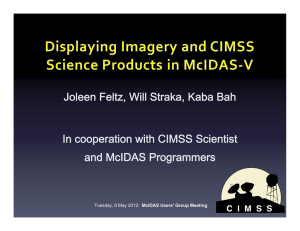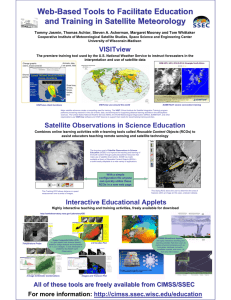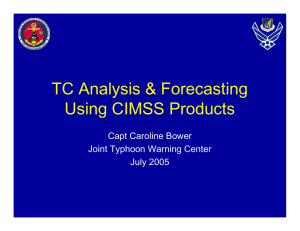Document 13541617
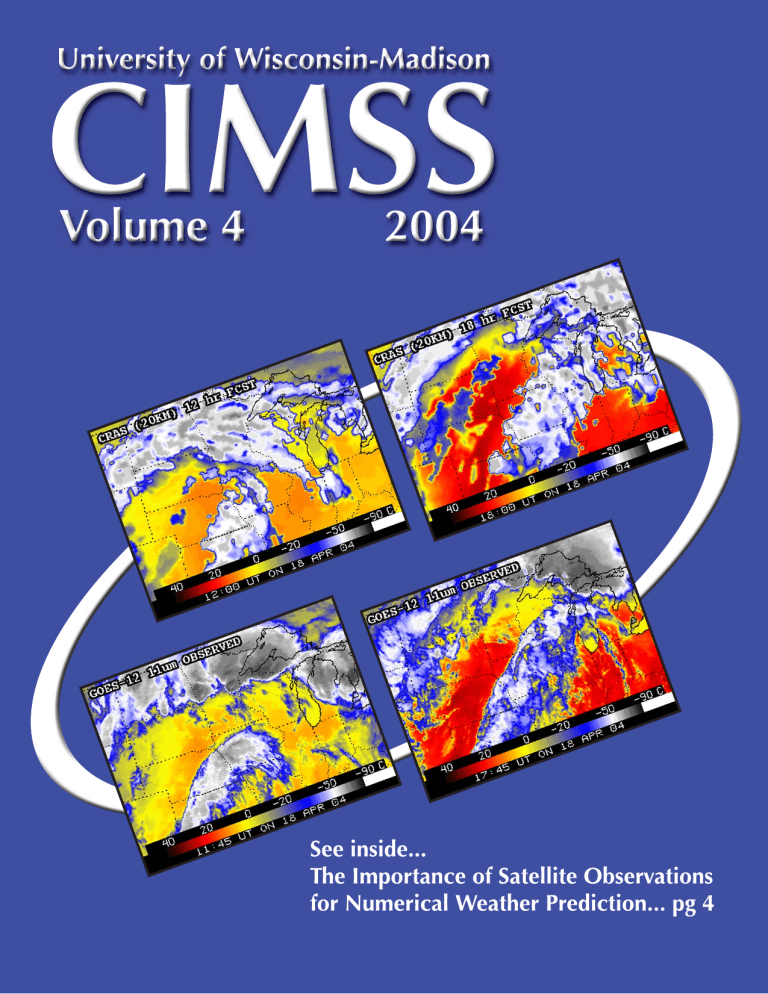
CIMSS Mission
CIMSS
is a joint University of
Wisconsin, NASA, and NOAA institute, officially created through a
Memorandum of Understanding, to provide for cooperative research on the applications of earth orbiting satellites to the observations of the earth’s surface and atmosphere and their application to the analysis and prediction of weather and climate. CIMSS operates within the Space Science and Engineering Center
(SSEC) at the University of Wisconsin-Madison.
CIMSS is a world class center conducting research on weather and climate through the interpretation and use of operational and experimental satellite observations and remote sensing data acquired from aircraft and the ground. These data are applied to a variety of atmospheric and oceanographic studies and evaluated for their potential operational utility.
CIMSS works with NOAA to transfer these new useful technologies into operational practice.
Current research also focuses on the development and testing of computer-based analysis and forecast techniques that use observations from existing and planned spacecraft and ground-based weather observing systems as part of a national program to improve weather forecast capabilities for the next decade. The optimal use of satellite data in climate and global change studies has become another essential part of our mission.
From these investigations CIMSS researchers identify new observations necessary to understanding the earth’s atmosphere and work to develop new measurement concepts, leading to a major role in instrument design and testing, and related software development, for improved spacebased measurements. CIMSS is very active in national and international field programs, testing new instrumentation and data processing systems, and assessing the usefulness of the new data.
CIMSS serves as a collaborative training ground through its visiting scientist program, hosting several foreign scholars each year, and through its relationship to the UW-Madison
Department of Atmospheric and Oceanic
Sciences, providing graduate student research support to more than ten students per year.
CIMSS Board of Directors
Martin Cadwallader, Steve Ackerman, Hank Revercomb, John Young, Gregory Withee, Marie
Colton, Jeff Key, Ghassem Asrar, Leonard McMaster, Franco Einaudi
CIMSS Scientific Advisory Council
Steve Ackerman, Allen Huang, Chris Velden, Ralf Bennartz, John Norman, Arnie Gruber, Fran
Holt, Robert Ellingson, Graeme Stephens, Pat Minnis, Michael King
Editor: Leanne Avila
Original Design by Betsy True Revised by Leanne Avila
CIMSS
Cooperative Institute for Meteorological Satellite Studies
University of Wisconsin-Madison
1225 W. Dayton St.
Madison, WI 53706
608-263-7435 http://cimss.ssec.wisc.edu/
CIMSS • 2004
2
Note from the Director
W eather forecasting has always relied on careful observations of the environment. What has changed over the years is the number of observations and how they are used in the prediction process. Nearly
30 years ago my senior project for my physics major was to program a barotropic model. For input to the model, I had to overlay a 500 mb
(hPa) map with a transparency with grid points marked, read off height contours that I then typed onto punch cards, which I handed over with the rest of the program to an operator to run on a computer. If I was lucky, and nice to the operator, I could get 3 runs completed in a
24 hour period. Today I can run a barotropic model as a java applet from a web page that yields 3 runs in 30 seconds… no luck required.
Growth in computer capabilities and gains in knowledge about the atmosphere and numerical methods paved the way to complex forecasting models that have improved the accuracy of weather forecasts. Data input is automated and the volume excessively large.
As outlined in the first article of this newsletter, satellite observations are playing an increasing role in numerical weather prediction. Models continue to improve. With better handling of data and model capabilities, weather predictions get better. However, no matter how much we improve our forecasting capabilities, nature always has surprises.
Satellite observations enabled careful monitoring as the storm approached Brazil. The next generation satellites will lead to improved observations of the environment. But to make best use of these observations requires a capability to rapidly simulate these observations for use in weather and climate prediction models.
CIMSS' research activities include the development of better and faster radiative transfer models.
The South Atlantic hurricane created quite a buzz, and not just among scientists. People enjoy talking about the weather, about both prediction methods and the effects of weather on our lives. Stories and other folklore, such as rhymes, proverbs, omens, and traditional expressions, are an excellent way to approach the science and larger significance of weather.
Wisconsin Weather Stories is a one-year statewide program through which three partners, the Cooperative Institute for
Meteorological and Satellite Studies (CIMSS), the University of Wisconsin-Madison (UW)
Folklore Program, and the Wisconsin Arts
Board, worked with UW undergraduate students and 5 teachers to create a K-12 curriculum guide on the stories, sayings, science, and significance of Wisconsin weather. You will find more about this education and outreach effort in the last article of the newsletter.
Steven A. Ackerman
Director, CIMSS One of these unsuspecting weather events was a South Atlantic hurricane in late March.
Table of Contents
The Importance of Satellite Observations for Numerical Weather Prediction ................................4
A Storm for the History Books ....................................................................................................7
Physical Modeling for Processing Hyperspectral Infrared Data ....................................................8
Wisconsin Weather Stories ........................................................................................................11
Suomi Scholarship Award Winners Announced ........................................................................12
If you would like to be added to our mailing list to receive the CIMSS newsletter, please contact
Maria Vasys (email: maria.vasys@ssec.wisc.edu).
If you would like to learn more about CIMSS, please visit our web site: http://cimss.ssec.wisc.edu/
3
CIMSS • 2004
The Importance of Satellite Observations for Numerical Weather Prediction
Bob Aune, Tom Zapotocny, Jim Jung
T he concept of numerical weather prediction (NWP) - the process of using a computer to project the solution to a set of equations that mimic the behavior of our atmosphere toward future states - was first tested by L. F. Richardson in 1922 using adding machines and hand-drawn analyses.
His results were less than promising. The accuracy of his forecasts was questionable, and the amount of human labor required was prohibitive. The concept was not tested again until 1946, this time using a computational machine known as the Electronic Numerical
Integrator and Computer (ENIAC) at Princeton
University. A modified form of the same equations that Richardson used were solved for future atmospheric states producing forecasts with a measurable amount of skill.
As with the early attempts, NWP requires an accurate representation of the threedimensional state of the atmosphere from which forecasts are generated. Imperfections in the "initial state" will eventually cause errors to grow and result in forecast degradation.
Observations of atmospheric parameters provide information updates that are used to control the growth of errors over time. The process of using information from observations to minimize the growth of errors in our threedimensional atmosphere state is known as data assimilation.
Operational, or real-time, NWP became possible in the mid 1960s when computers became powerful enough to solve simplified equations
Figure 1 describing atmospheric flow. These first NWP systems used observations of the prognostic model variables, i.e., temperature, wind, and less often, humidity. These observations were only available from land stations or from instruments carried by balloons. The horizontal spacing of the observation sites was large, as was the horizontal spacing of the forecast model grids. As computer power soared, scientists began using higher resolution forecast models over larger areas, eventually spanning the globe. The need for more observations covering the entire globe became a necessity.
In the mid 1970s scientists began to consider using observations from instruments mounted on space-based platforms. These instruments, however, could not directly measure prognostic variables used by the assimilation schemes of that time. They observed the electromagnetic radiation emitted by the earthatmosphere system. Fortunately, data assimilation has evolved over the years from simple statistical interpolation schemes that process one prognostic parameter at a time to extremely complicated three-dimensional and fourdimensional systems that assimilate information from numerous observation types including remotely-sensed data from satellites.
The use of radiative transfer models to "forward calculate" what the satellite would see if it were sampling our three-dimensional model atmosphere provides the background against which satellite observations can be compared.
Since 1996 scientists at
CIMSS have been
4
CIMSS • 2004
Figure 2 shows a 12hr and 18hr forecast 11µm image from the CRAS
(top) and the corresponding images from GOES. Forecast images like these are not possible without the use of the GOES sounder cloud observations to prescribe the clouds in the model initial state. This work led to a collaboration with the
Mesoscale Analysis and Prediction
System group at the Forecast
Systems Laboratory (FSL) in Boulder, who developed the Rapid Update
Cycle (RUC) forecast model. The
GOES sounder cloud information is currently being used to initialize clouds in the operational RUC.
Figure 2. Top panels show the 12hr and 18hr forecasts of the
11µm brightness temperatures from the CIMSS Regional
Assimilation System (CRAS) valid 12UTC and 18UTC on 18 April
2004. The validating images from the GOES sounder are shown below each CRAS image for comparison.
involved with assessing the potential value of observations from the atmospheric infrared sounder onboard the Geostationary Operational
Environmental Satellite (GOES). Observations of vertically integrated water vapor were first evaluated using the CIMSS Regional
Assimilation System (CRAS). Initial experiments demonstrated the spatial and
More recently, the focus of the satellite impact studies at CIMSS has undergone a transition from regional models to global models. The NCEP
Global Forecast System (GFS) has now become the primary model studied, with scientific direction, funding and computer resources supplied by the Joint
Center for Satellite Data Assimilation (JCSDA).
Through collaboration with NCEP personnel, the following list (displayed in no particular order) of denial/addition experiments has been identified as deserving priority in diagnosing GFS strengths and weaknesses: temporal benefits of using the observations.
Next, with guidance from the National Centers for Environmental Prediction (NCEP), assimilation experiments were conducted using integrated water vapor retrievals in the NCEP
Eta Data Assimilation System (EDAS). These experiments resulted in the operational use of the GOES sounder observations in the EDAS.
1.
2.
3.
4.
Remove microwave data (AMSU-A and -B combined)
Remove IR data (HIRS)
Remove NOAA 15 data (to simulate a single
POES failure scenario)
Remove all conventional data
By 1999, forecast models began to explicitly predict clouds. This was done, initially, without the use of any cloud observations. Using the CRAS, CIMSS scientists demonstrated that cloud information from the GOES sounders could be used to improve the numerical prediction of clouds.
5.
6.
7.
8.
Remove all rawinsonde data
Remove all geostationary wind data
Remove all satellite data
Add MODIS winds to the operational data stream
5
CIMSS • 2004
decay has been conducted. Finally, the
Anomaly Correlation (AC) of several conventional meteorological fields has been included in the diagnostic package.
A two-dimensional surface pressure difference field and 500 hPa geopotential height anomaly correlation display for zonal waves numbers 1-20 are included as examples of the types of diagnostics routinely produced. The two-dimensional plot was generated from the denial experiment which removed microwave data (No AMSU) during the northern hemisphere winter while the AC plot includes results from the "No AMSU" case and "No
Conventional" experiment.
Key findings from the handful of experiments diagnosed thus far have identified that AMSU data provides the
Figure 3. Difference in sea-level pressure (hPa) at 5 days between the "control" simulation and the "AMSU" denial, time averaged for the period 15 January-15 February 2003.
Largest impacts from AMSU data are poleward of 30 degrees in each hemisphere.
All simulations include pre-operational versions of the Spectral Statistical Interpolation
(SSI) algorithm for data assimilation and forecast model and are integrated to 16 days using the operational resolution. Two separate time periods including opposite seasons are studied in this work. They include 01 January through 15 February 2003 and 01 August through 20 September 2003. The first time period includes a span of reduced forecast skill from the GFS. The second time period, while not during the height of the northern hemisphere summer, was extended to encompass several tropical systems, including
Hurricane Isabel.
Forecast impacts (whether positive and negative) have been evaluated over both the entire global domain and within subsections traditionally used by NCEP for the global system (20-80 N and S and within the tropical band 20 N/S). An additional benefit of integrating these simulations to 16 days is that a temporal evaluation of the forecast impact
Figure 4. Day 0-16 500 hPa geopotential height anomaly correlation coefficient for 20-80N during the period 15 January-15 February 2003. The
"control" simulation is shown in blue, with the
"AMSU" and "conventional" data denials shown in magenta and green, respectively. This figure shows how the forecast is more accurate with both of these data types included. These results have been truncated to highlight zonal wave numbers less than 20.
CIMSS • 2004
6
largest forecast impact to the most meteorological variables in all subsections studied. In fact, AMSU data increases forecast skill in the northern hemisphere by about 12 hours at 5 days and 18 hours at 5 days in the southern hemisphere. HIRS forecast impacts are most positive for moisture fields in the northern hemisphere summer. It is important to note that at press time results from the geostationary wind, all satellite and MODIS experiments discussed above had not been evaluated.
Today, all major operational NWP centers rely on satellite observations to control the growth of errors in their NWP systems. While in situ observations continue to contribute information to the initial state, satellite radiance data currently represents the largest single observation type used in assimilation systems. Prof. Verner Suomi once dreamed of an "all satellite" prediction system using only remotely sensed observations. The development of hyperspectral instruments coupled with Kalman filter assimilation techniques may make his dream a reality.
A Storm for the History Books
Chris Velden
D uring the week of 22-28 March 2004, an extremely rare meteorological event took place in the southern Atlantic Ocean.
What appears to be a hurricane developed from a cutoff extratropical system off the coast of
Brazil. For several days, this system transformed into a storm with tropical cyclonelike characteristics. A clear eye and eyewall
The warm core of the Brazilian tropical cyclone is depicted in this AMSU-A image, produced at CIMSS, from 26 March 2004.
MODIS image of the storm from 26 March 2004.
Image courtesy of NASA’s Visible Earth gallery
(http://visibleearth.nasa.gov/).
developed as it moved towards the coast of
Brazil. Upon landfall, this system caused considerable damage and resulted in a few deaths. It has yet to be confirmed, but this storm could be recognized as the first southern
Atlantic hurricane in recorded history.
7
CIMSS • 2004
Physical Modeling for Processing Hyperspectral
InfraRed Data
Jim Davies, Allen Huang
C IMSS has teamed with the University of
Hawaii-Hawaii Institute of Geophysics and Planetology (UH-HIGP) to collaborate on the physical modeling of hyperspectral* data for the Multidisciplinary Research Program of the University Research Initiative (MURI).
Together, CIMSS and UH-HIGP have over 30 years of experience in the processing and analyzing of infrared spectral data for the characterization of weather and atmospheric chemistry, as well as for the detection, classification and identification of land-surface materials.
The objective of this program is to develop and demonstrate a fully functional hyperspectral data processing system.
Modeling has focused initially on GIFTS
(Geostationary Imaging Fourier Transform
Spectrometer), an instrument which could provide a revolutionary step in hyperspectral imaging from geostationary orbit. The original concept for GIFTS was developed by UW-
Madison/CIMSS in partnership with Utah State
University Space Dynamics Laboratory. GIFTS blurs the distinction between imaging and sounding, by providing data with the spectral resolution needed for advanced sounding from
Figure 2. The real (upper panel) and imaginary (lower panel) parts of the index of refraction, as a function of wavenumber for important aerosol species. over 16,000 4-km pixels in just 10 seconds.
The infrared radiation reaching a satellite depends upon emission and absorption characteristics of atmospheric gases, aerosols, clouds, and the surface of the Earth. Figure 1 shows a simulated clear sky infrared topof-atmosphere spectrum including the spectral features of key radiatively active atmospheric trace gases. Here the spectral variation is due solely to the differential absorption of atmospheric gases. Clear sky calculations are made at
101 pressure levels and take into account the satellite zenith angle, absorption by well-mixed gases (including nitrogen, oxygen, and carbon dioxide), water vapor
(including the water vapor continuum), and ozone.
Figure 1. GIFTS spectral coverage with two detector arrays, showing spectral features of key radiatively active atmospheric trace gases. In this example a clear sky infrared topof-atmosphere spectrum has been simulated.
The differential absorption, emission and scattering of both long- and shortwave radiation can be used to identify the presence of suspended particulate matter
*For the purposes of this article, the term hyperspectral refers to a measurement resolution of 1 cm-1.
8
CIMSS • 2004
such as dust, sand, volcanic ash, and smoke. Each aerosol species has a different "spectral signature" caused by the unique differential scattering, absorption and/or emission it produces. The spectral signatures are determined from observations and radiative transfer calculations. Figure 2 shows the refractive index for several important aerosol species. The level of spectral variation shown therein suggests that hyperspectral measurements present a great opportunity, as well as challenge, to study the suspended particulates in the atmosphere.
The absorption and emission of radiation from natural surfaces
(e.g., rock, soil, vegetation, seawater) and man-made materials
(e.g., asphalt) can be modeled using laboratory and field measurements.
Figure 3 shows examples of the substantial surface emissivity variations that occur in natural materials. The upper panel of the figure shows the spectral emissivity of seawater, grass and soil in the
GIFTS primary infrared spectral region, and the lower panel shows the impact of emissivity on GIFTS radiance measurements.
Due to the distinct optical properties of different surface types, the uniquely-measured hyperspectral signal of a given surface or material can be inverted to retrieve its identity and characteristics within the GIFTS field of view (once atmospheric effects are
Figure 3. Emissivity spectra of seawater, dry grass, and soil surfaces and their brightness temperature spectra at the top-ofatmosphere. Brightness temperatures are computed under clear sky conditions and shown for a portion of the spectral coverage of the GIFTS instrument.
accounted for). The GIFTS instrument is well suited to this purpose considering the infrared atmospheric interference to be minimized by observing between spectral absorption lines.
Further, the combination of on-line and off-line observations also allows the separate effects of window region it will sense and its high spectral resolution. In particular, the high spectral resolution allows the effects of surface temperature and emissivity to be distinguished.
9
CIMSS • 2004
A feature of the radiative transfer modeling completed to date is the ability to rapidly generate simulated radiances over a wide spatial domain with each location represented by realistic surface types and atmospheric conditions. Figure 4 shows simulated radiances generated by the GIFTS forward radiative transfer model from atmospheric conditions estimated by a model of atmospheric heat and moisture transport, here simulating a case of convective initiation.
We anticipate that the CIMSS and UH-
HIGP research synergy will continue to grow as we seek to evaluate surface emissivity, how surface effects influence atmospheric retrievals, and how atmospheric effects influence surface characterizations. Land surfaces are made or constructed with specific materials that have unique spectral properties dictated by their chemical composition. While the spectral properties of a material can be used directly as a signature input to a hyperspectral detection algorithm (e.g., a matched filter), the robustness of this signature is poorly constrained without understanding the phenomenology behind the signature. As a common example, fresh oil (i.e., an oil slick) differs from weathered or dried oil, and surface oil exposed to different conditions can give rise to different spectral signatures. Therefore there is no single signature for a given material (oil for example), but a range of signatures against which a robust detection algorithm must perform. Similar arguments can be made regarding natural and urban backgrounds; they contain a host of signatures associated with classes of materials and scene elements for which complete characterization is impractical.
We continue to focus on a physics based approach to predicting the signature of a major constituent of infrared hyperspectral backgrounds in the thermal infrared region of the spectrum. The process is intended to explore the power of this approach, which aims at directly connecting the chemical composition and physical structure of the surface to the emitted radiance. The goals of this research are to confirm the value of the physics-based approach for surfaces (an approach well validated for atmospheric phenomena), to apply the predictive model to the application of soil spectral phenomena, and ultimately to use the predictive model to invert signatures to chemical composition and physical state.
Figure 4. Simulation of convective initiation observed during the International H2O Project
(IHOP). The left panel shows the development of high, cold, convective cloud (in dark blue) and lower, warmer stratus cloud (in red). The right panel shows the radiance at 935 wavenumbers.
CIMSS • 2004
10
Wisconsin Weather Stories
Anne Pryor
“
T o us, this is common knowledge. When you see deer feeding heavy and early, you know there is a storm coming. I often wondered if that had to do with the fact that they are covered with so much hair and they can feel the difference in atmospheric pressure. They must have that ability. You know, whenever there is a storm coming, the animals feed. If you always see deer out all the time, you know darn well there is a storm coming.” interdisciplinary avenue to engage students and teachers in a new way. We offered
Wisconsin teachers the opportunity to apply to work with our team, to learn more about weather and atmospheric phenomena through
Wisconsin folklore, and to incorporate the new knowledge and materials into their classroom.
The five teachers in our project represent a broad academic, cultural, and geographic range: Mary Kornely teaches 4th grade at
Denmark Elementary School, Mary Jo Fuhry
When Russ Bailey-Port Wing native, fisherman, logger, butcher, hunter, and 7th grade science teacher at Northwestern Middle
School-shared this local knowledge last summer, he exemplified the focus of the
Wisconsin Weather Stories project. What signs do Wisconsinites use to predict the weather?
What sayings come about because of those observations? What atmospheric principles might be behind Wisconsin weather lore?
coordinates elementary science education at
Milwaukee’s Indian Community School,
Teyulelu Cornelius is the Talented and Gifted
Specialist at Oneida Tribal School, Karyl
Rosenberg teaches science at Nicolet High
School in Glendale, and Russ Bailey regularly incorporates riveting weather stories into his science classes in Maple.
Russ is one of five K-12 teachers who have been working with a team of Madisonbased folklorists and atmospheric scientists over the past year. The team is led by
Each teacher works directly with a folklore or atmospheric science student who is part of the Madison-based team. These exceptionally skilled undergraduates write curricula, conduct research, create digital
CIMSS Director
Steve Ackerman,
Anne Pryor
(Wisconsin Arts
Board), and Jim
Leary (University of Wisconsin-
Madison Folklore
Program).
While CIMSS has long been involved in outreach efforts to
The Wisconsin Weather Stories team bring enthusiasm for atmospheric science and research to teachers and students throughout the state,
Wisconsin Weather Stories offers an material, and assist the K-12 teachers as needed. Holly
DeRose and
Kristopher
Karnauskas are the project's atmospheric science students.
Claire Schmidt,
Louie Holwerk and
Jamie Yuenger are the folklore students in the project.
The teachers attended a two-day training session in Madison during Summer 2003. In addition to lectures on project philosophy, local
11
CIMSS • 2004
culture, and narrative, the workshop included sessions illustrating how to conduct interviews, do fieldwork, use weather stories in the classroom, and access weather resources. The teachers also evaluated an on-line lesson that features a first person account of the Armistice
Day Storm of 1940 by duck hunter Harold
Hettrick. An additional work session with the teachers occurred in Madison in April 2004.
Wisconsin Weather Stories will conclude in
June 2004 with a Web site developed by the
Madison team that contains curricula in three areas: severe weather stories, weather sayings, and occupational lore of meteorologists. The website also will contain content submitted by the teachers: student-collected weather sayings and stories; interviews with local knowledge bearers; and lessons written on the storm that sunk the Edmund Fitzgerald, fire storms in the north-south corridor along Lake Michigan, the
1967 “Ice Bowl” in Green Bay, and Woodland
Indian seasonal lore. The Web site will be freely available for public use.
The interdisciplinary lessons that come out of the Wisconsin Weather Stories Project will illustrate how weather lore makes strong curricular links between the narrative arts, earth science, and social studies. “The longterm goal is an integration of teaching, storytelling, and weather together,” Steve
Ackerman said.
Major funding for the Wisconsin Weather
Stories project is provided by the Ira and Ineva
Reilly Baldwin Wisconsin Idea Endowment out of the University of Wisconsin Office of the
Provost.
For more information on Wisconsin Weather Stories, please visit us on the Web: http://cimss.ssec.wisc.edu/wi_weather_stories/
Suomi Scholarship Award Winners Announced
CIMSS is pleased to announce the winners of the seventh annual Verner E. Suomi Scholarship
Award for Outstanding Achievement in the Physical Sciences:
• Katherine Behrendt , from Waukesha South High School, plans to major in Materials
Engineering at the University of Wisconsin-Madison.
• Jacob Cychosz , from Waunakee High School, plans to major in Astronomy/Physics at the University of Wisconsin-Madison.
• Elise Gorchels , from Madison West High School, plans to major in Astronomy at the
University of Wisconsin-Madison or the University of Wisconsin-Milwaukee.
• Victoria Vasys , from Madison Edgewood High School, plans to major in Electrical
Engineering at the University of Wisconsin-Madison.
CIMSS • 2004
12
